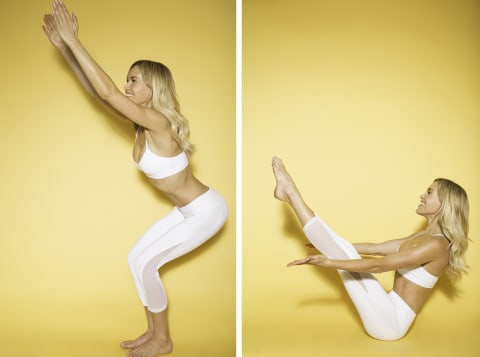Advertisement
Vinyasa Yoga 101: Everything To Know About This Fast-Paced Flow

If you're a newcomer to the mat, you may have some questions about the different types of yoga. For example, what yoga variety should you choose for a more intense workout?
If you're in the market for a fast-paced flow, consider vinyasa yoga your go-to version. Before you try it out—in a studio or virtual class—learn exactly what this type of yoga entails, its potential health benefits, and how to practice.
What is vinyasa yoga?
"Vinyasa yoga has come to mean poses linked together by the breath," explains Lisa Maria, RYT-200, national workshop director at YogaWorks and certified yoga instructor. That means all movements in a vinyasa class are coordinated with your breathing, and there's no break in between poses. Instead, "you're just dynamically moving from one to the next," Maria says.
Tara Stiles, mbg collective member and founder of Strala Yoga agrees. "Allow your body to move along with the ride of your breath," she says in mbg's Complete Guide to Yoga class. "So your inhale is literally lifting you and opening you into movement, and your exhale is literally twisting you or moving you a little farther along, whatever the movement is."
This dynamic movement can flow at a rapid pace—or it can be really slow. Whatever the speed, all vinyasa classes share "that element of moving dynamically with the breath," says Stiles.
What to expect in a vinyasa yoga class.
All vinyasa classes will probably start with an intention-setting phase and end in final relaxation. But in between, the format, pace, and other aspects will deviate from class to class.
In some vinyasa classes, the teacher might call out poses with the expectation that students will know how to do them. In other vinyasa classes, like in alignment-based vinyasa classes, the teachers will provide more instructions on how to perform postures. There are also vinyasa classes that combine vinyasa with other types of yoga, like yin or restorative, and some vinyasa studios that are heated, says Maria.
As you move through your vinyasa class, don't push yourself into poses you don't know. If all of your classmates are busting out headstands, for example, and you've never done one before, now is not the first time to try.
Instead, respect your current level, and if you need to take a breather, do so without worry. "It's totally acceptable to take a break," says Maria. "It's respected; it shows that somebody is taking care of themselves."
Types of vinyasa poses (asanas).
Typically, vinyasa classes will incorporate a variety of postures, or asanas. Think standing, seated and supine poses, twists, balancing poses, forward folds, inversions, and backbends.
Here are a few examples of poses and sequences you may see in class (demonstrated by yoga instructor Claire Grieve):
Plank, chaturanga

Downward-facing dog, one-legged dog, knee to nose

Chair pose, boat pose

Also typical: Most classes will build toward a "peak pose" using a sequence of movements that progressively open the body, explains Maria (think crow pose or headstand).
During your vinyasa class, you might hear the teacher say the word "vinyasa," which generally cues people to perform a repetitive sun salutation sequence that starts with a chaturanga and ends in a downward-facing dog. If this happens and you're confused, simply follow along as best you can, Maria suggests. Or you can use this time to do your own thing entirely, like hold a plank, move to downward dog, or rest in child's pose.
Vinyasa yoga flows at home.
Can't get to a studio? Or just want to test out vinyasa at home first? Try one of these great yoga workouts:
Potential health benefits.
Vinyasa yoga, in general, is good for building strength and flexibility, says Maria. Faster-paced vinyasa classes can also provide more of a cardio challenge than other types of yoga, like hatha, that include breaks in between poses. A study that measured the heart rates of 38 people who took a 50-minute vinyasa class concluded that vinyasa yoga is primarily a light-intensity aerobic activity (though individual responses varied).
Should you try vinyasa?
Vinyasa is great for especially athletic folks, says Maria. "It tends to be a more vigorous class," she explains. Vinyasa could also be a good option for people who are somewhat restless, she adds, as it allows you to move around more than you would in a slower-paced form of yoga (like certain hatha classes, for example).
If you're brand-new to yoga, you may want to take a beginner-friendly class (like some hatha classes) or an Iyengar class (a form of hatha that focuses on proper alignment and precise technique) before jumping into vinyasa, says Maria. That way you can correctly learn poses before practicing them in the quick-flow format of vinyasa.
Lastly, strenuous, fast-paced vinyasa classes aren't a good idea if you have knee, shoulder, or neck issues, says Maria. And of course, if you do have any type of injury, chronic illness, or history of pain—of if you're pregnant—you should check with your doctor before trying vinyasa for the first time.
The bottom line.
Vinyasa yoga is all about rhythmic movements timed to the breath. Depending on the pace, vinyasa can be more intense than other styles of yoga, which makes it great for athletic class-goers. If you're looking to find a (potentially) sweaty flow, consider giving vinyasa a try.